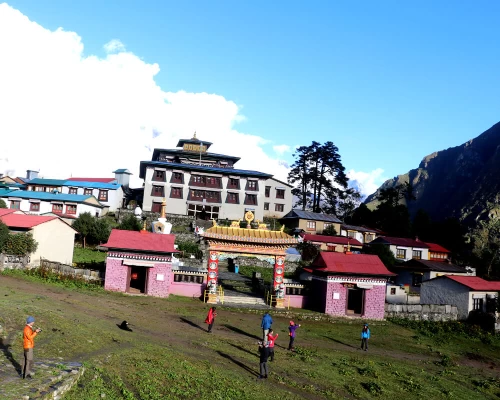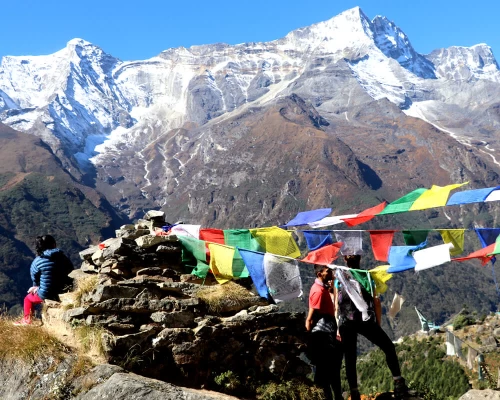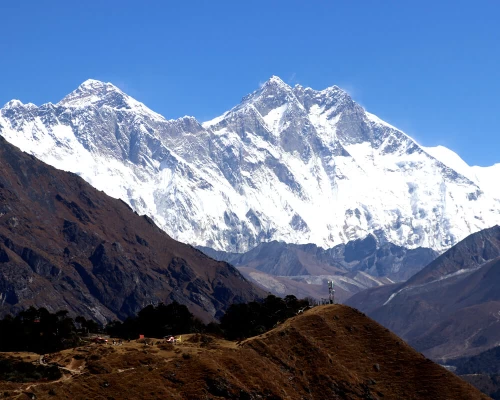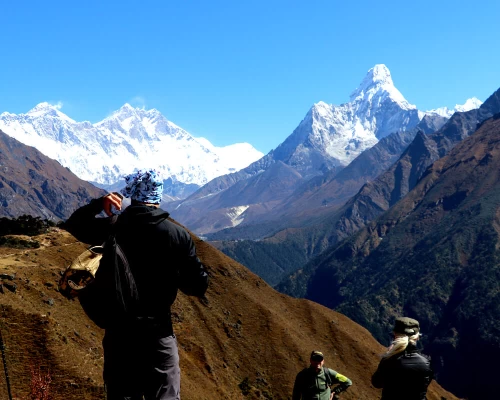Flight to Lukla
Flights to Lukla are now operating from Ramechhap Airport in Manthali due to too much air traffic at the Kathmandu Airport. Ramechhap Airport is 132 kilometers (4 hours' drive) from Kathmandu. Early in the morning, our team will drive to Ramechhap Airport for the Lukla Flight.
The flight duration is 15 minutes. Again, when you finish the trek, you will fly back to Manthali and drive to Kathmandu. The flight to and from Lukla might be delayed due to the bad weather, so in this situation, we will find another suitable option for you.
7-Day Everest View Trek Itinerary
Our detailed itinerary is designed with years of experience in the Everest region. The itinerary gives you an idea of the trekking trail and what kind of views you get along the way. With us, trekkers can book their trip confidently. This itinerary is flexible, depending on your desires and how much time you would like to spend on the trail.
You need to let your guide know at least 1 day in advance if you want to add an extra day or shorten the trek, as we need to manage the flight out from Lukla. We have laid out the perfect itinerary for the Everest View Trek, which includes all the popular places of the Everest Base Camp Trek.
Accommodation on the 7-Day Everest View Trek
Accommodation on the Everest View Trek, in general, is a little better than on the Everest Base Camp Trek. This is because there are plenty of guesthouses with proper amenities, unlike in the higher regions. If you prefer, there are a few hotels with luxury service.
If you want a luxury room with an attached bathroom each night, we can provide that for an additional cost. Included in the package are neat and clean rooms with a blanket, a decent mattress, and rooms with incredible mountain views.
Meals and Beverages During the 7-Day Everest View Trek
Three meals a day are included in the cost. Every meal on the Everest View trek will be filling and super tasty. Cooks are experienced and know how to cook up a delicious dal bhat. The menu at each guesthouse is relatively similar, with both local and international options.
You’ll find options like pizza, pasta, sizzler, steak, fried noodles, dal bhat, fried potato, Swiss roast, and more. The locally sourced vegetables give you all the energy you need to climb up the mountain. All kinds of beverages can be found on the Everest View Trek. Extra beverages (i.e., beer, cold drinks, etc.) are not included in the package cost.
Drinking Water during the 7-Day Everest View Trek
The most important part of a trek is finding pure drinking water. Bottled water is available, though it should be avoided at all costs. We advise bringing purification tablets, like iodine, or a chlorine purification technique, or a filter. Then, you can drink the nice, pure river water from the Himalayas.
Guide and Porter for the Trek
Highly professional, government-licensed trekking guides and porters will lead you on the trail. Accommodation, food, transportation, salary, and insurance for the guide and porters are included in the cost of the package. The porter will meet you in Lukla, while our guide joins you from Kathmandu.
All members of our team are first aid certified, as well as trained in high-altitude sickness prevention and treatment. Take the Everest View Trek with confidence knowing that your guides are medically trained and certified.
Acclimatization Day on the 7-Day Everest View Trek
Acclimatization days are necessary on any trek that exceeds 4000 meters in altitude. Acclimatization is the process of allowing your body to get used to a lower level of oxygen in the air. The key to this is hiking higher and sleeping lower.
Acclimatization on this trek is built into the third day of the trek, at Namche Bazaar. On this day, you will hike up to Everest Viewpoint, Khumjung Village, and back to Namche Bazaar to sleep. Then, you will be thoroughly prepared to head up to Tengboche the following day.
Communication/WiFi
As the most popular trekking region, the Everest Base Camp trail is ultra-developed, so cell service and Wi-Fi are very accessible. You can use a local SIM card in Tengboche, the highest point of the trek. You may want to make video calls and stay connected with the outside world. You can buy the Everest Link WiFi pack and use it during your Everest View Trek.
You can buy a card with 10 GB or 20 GB, depending on how much internet you plan to use. The costs start at Rs 2500 for 10 GB cards. You can’t use the Everest Link WiFi in Kathmandu – the cards can only be used exclusively in the Everest region.
Charging/Toilet
Electric accessibility on the Everest View Trek is very adequate. There are micro hydro-power stations in each village, so you can charge your phone, camera, and other gadgets easily. There will be a charging point at every guesthouse as well. You can give your gadgets to the guide, and they will take care of the charging. The toilets and guesthouses are not as bad as those in other treks in Nepal. There will be western toilets in every guesthouse and a bathroom on a sharing basis.
Altitude Sickness
The risk of altitude sickness on the Everest View Trek is very low compared to the Everest Base Camp Trek. This is because the trail doesn’t reach any higher than 3867 meters in altitude. Trekkers can begin to feel symptoms of high altitude sickness above 4000 meters. This trek leads just up to Tengboche with day acclimatization in Namche Bazaar, so the chance of high altitude sickness is very low.
You can avoid altitude sickness by drinking enough water, getting a full night’s sleep, and enjoying the amazing views of the Everest region. Though it is unlikely, if you feel any symptoms of altitude sickness, please tell our guide immediately. They will make the right decisions to minimize the risk.
The Most Popular Places in the 7-Day Everest View Trek
Everest View Trek leads into the most popular region in Nepal – the Everest region. Many of the most popular places along the Everest Base Camp Trek can be seen in this short trip. Here is a list of the most popular places on the Everest View Trek:
Lukla Airport
The Everest View Trek is full of excitement from the moment you take off in Ramechhap. The early morning flight is quite a thrill, especially landing on an airstrip that sits on the edge of a cliff. In fact, in 2010, the History Channel deemed the Lukla Airport the most dangerous airport in the world.
The infamous airport was built in 1964 with the help of Sir Edmund Hilary and the Nepal Government. During your flight, you can see mountains of all sizes from your window. Once you disembark, you’ll feel immense joy knowing that you’ve reached the gateway to the Everest region.
Namche Bazaar
Namche Bazaar is the biggest town and commercial center of the Everest region. After your trek, it is the best place to chill out and have a beer in one of the many bars in town. On Saturdays, there is an awesome little local market, where you can buy local Sherpa handicrafts among many other things.
On your acclimatization day, spend an hour or two wandering the streets. Also, checking out the various bakeries, galleries, cafes, and restaurants at Namche Bazaar. This little tourist hub is a must-see place on any Everest region adventure!
Sagarmatha National Park Viewpoint
Everest View Point gives you your first glance at the world’s most legendary mountain. Seeing Mount Everest for the first time is an unforgettable moment. A few hundred feet above Namche Bazaar, you can see the expansive Khumbu Valley and several of the highest mountains in the world.
Hotel Everest View
On your acclimatization day in Namche Bazaar, one place you will see is the Everest View Hotel. As the name suggests, the place has stunning views of Mount Everest. At 13,000 feet above sea level, Hotel Everest View is officially the Highest-placed Hotel in the World. It is according to the Guinness Book of World Records (2004).
In the morning, on the way to Khumjung Village, it is the perfect spot to have a cup of tea. And relax while absorbing the peace and serenity of this beautiful place. The 360-degree panorama gets you excited for the even more glorious view the following day!
Khumjung Village
The final destination of our acclimatization hike from Namche Bazaar is Khumjung Village. Ascending higher and higher above Namche, incredible mountain views begin to appear. The village is small and charming, with little stone houses clustered around the flat grassy area.
At the highest point of Khumjung village, there lies a famous old monastery. Within this monastery lies an alleged Yeti scalp, the fabled creature that is known to roam the Khumbu region. Take a look at it and wander around the monastery. Afterward, you hike back down to Namche Bazaar, feeling good after the acclimatization hike.
Tengboche Monastery
The oldest and largest gompa in the region, Tengboche Monastery, is an absolute gem. At 3867 meters, it is the highest point of the trail and offers beautiful Himalayan views. One highlight of the Everest View Trek is participating in the daily puja at Tengboche Monastery, which happens at 6 a.m. and 3 p.m.
Meditating with monks in the early morning is an experience that you will cherish for life. Tengboche village is also a great place to witness Sherpa culture and their devout adherence to Tibetan Buddhism. The view from the back of the monastery is the best view you’ll have throughout the trek, so enjoy it!
Frequently Asked Questions
Is there a trek to see Mount Everest?
Yes, there are treks to see Mount Everest. Though you are unable to summit the Everest, you can enjoy the breathtaking beauty of the highest peak via the Everest Base Camp trek. Luckily, EBC trekking Nepal is available in both short and long packages. You can also do a luxury helicopter tour for a few hours if you want to see Mount Everest.
Besides these, Everest View Trekkings are also getting a good response these days. The trekking in the surrounding regions of Everest is short and easily accessible for the Everest views. These are perfect for quick getaways. You can enjoy Pikey Peak Trek, Namche Bazaar Trek, trekking to Tengboche and more.
What is the difficulty level of the Everest View Trek?
The Everest View Treks are comfortable and can be completed in a short time. Interestingly, people of all age groups and physical conditions can access these treks. They don't need to trek for long hours; all they can do is enjoy the close view of Everest.
If you are considering the Everest Camp Trek, then it is a moderate trek. If you are considering Pikey Peak Trek, the also it will be moderately difficult. If you want clear Everest Views without much trekking, then consider trekking in Pikey Peak Base Camp.
Can you see Mount Everest without climbing?
Yes, you can see Mount Everest without climbing. In fact, Everest View Tours is growing rapidly. Reaching the surrounding areas of Everest allows you to enjoy close and clear views of the highest peak. You don't have to climb mountains, just walk for some hours, and you will see stunning views of Everest. You can consider Everest Base Camp, Everest View Hotel, Pikey Peak Base Camp and Namche Bazaar Trekking.
What is the altitude of the Everest View Trek?
The altitude of the Everest View Trek can range from 3440 meters to 3880 meters in the Himalayan Region. From this altitude, altitude sickness becomes common, so trekkers need to be aware of that.
Where is the best viewpoint of Everest?
The best viewpoint of Everest is Everest Base Camp. This is a moderately difficult trek for beginners. You will enjoy clear and close views of stunning Everest from here. Similarly, Pikey Peak trek is another best option for 360 degree views of Everest. If you don;t want to climb, then PIkey Peak Base Camp also works best for the views of Everest and surrounding peaks.
So, 7 day Everest View Trek in the Everest Region is the best option for your Everest dream. You will enjoy close and mesmerizing views of the highest peak without summiting.



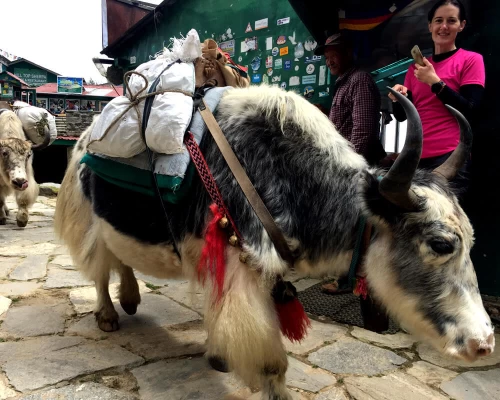

.webp)
.webp)
